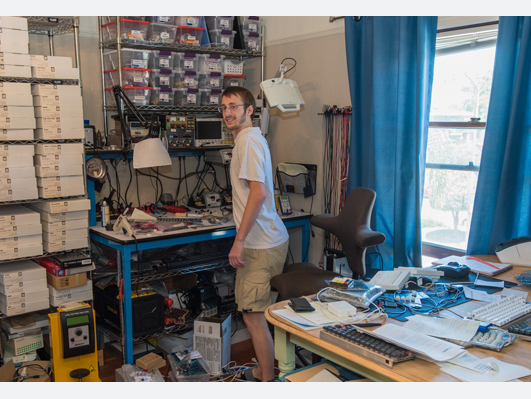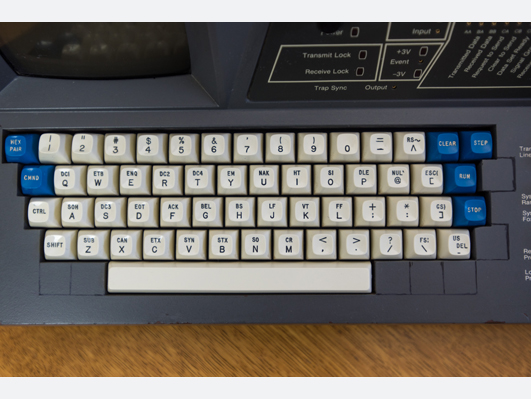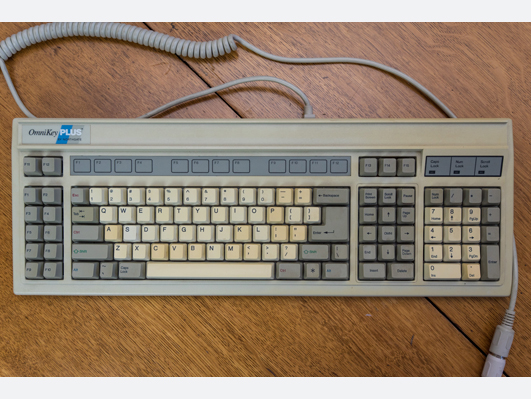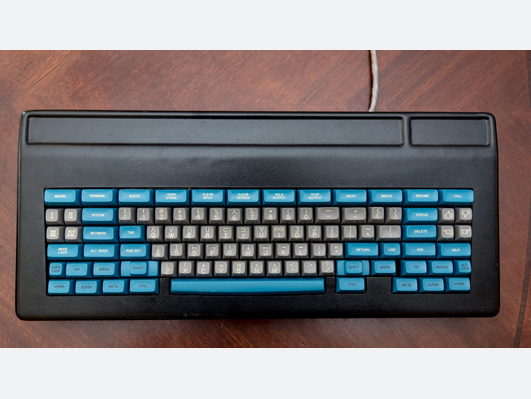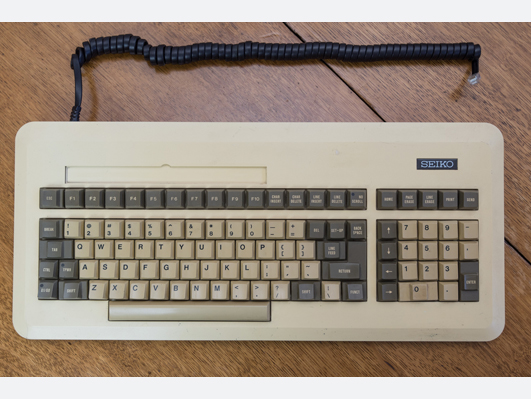History Of Mechanical Keyboards
Introduction
Throughout history, humanity has tended to produce great products, only to later phase them out in favor of worse, but cheaper ones. So it has often been with computer keyboards.
This is a tried and true tale of woe for anyone who has fallen in love with "buy it for life" objects of days past. What follows is a look into the past world of mechanical keyboards, high-end input devices that provided typing joy to millions. The keyboards that came out with your father's computer were often significantly better than what we commonly use today. Time was, computers could cost upwards of $10,000 apiece, so having a wonderful keyboard made the sales pitch a bit smoother.
We interviewed and photographed the collection of keyboard archaeologist, Jacob Alexander. We asked him to show us some of the most notable keyboards in history, to better understand how we got to the current state of typing technology. Some of the keyboards in this collection helped develop modern programming languages such as Lisp. Others were collaborations between the United States and the USSR during the Cold War. One of the keyboards even uses acoustic signals and has more in common with a grand piano than any other object.
Read on to learn everything you didn’t know you wanted to know about the predecessors of today's mechanical keyboards.
MORE: Best Cases
MORE: In Pictures: 40 Unusual Computer Case Mods
MORE: All Case Content
Get Tom's Hardware's best news and in-depth reviews, straight to your inbox.
Alps SCB1A163
This keyboard was from the first computer at UCLA, making it an artifact of mild fame. It's an early keyboard from Alps, a company that would go on to make all the Apple Computer keyboards. Built in the early 1970s, each switch can actually be pulled out of the keyboard by hand. Technically, they are mechanical reed switches, so each switch has a hermetically sealed tube with two metal reeds.
When you pass a magnet by this tube, the reeds touch, and the keyboard registers a keypress. These are contactless switches, so they will last for hundreds of millions of presses, far exceeding what today's keyboards promise.
Every switch also had a diode as part of the design, in order to simplify their circuit board manufacturing and allow for hand assembly. The keyswitches also make use of advanced plastics and have incredible manufacturing tolerances. If that wasn't enough, the keyswitches were designed to be muffled so they wouldn't upset or annoy co-workers or other people around the computer, a feature showing a significant degree of empathy and insight into the human experience.
MORE: Best Cases
MORE: Tom's Hardware's Top 40 Steampunk Computer Mods From Pinterest
MORE: All Case Content
IBM 3276 Data Entry Keyboard
IBM keyboards were one of the earliest keyboards to make use of capacitive sensing Beam Spring switches, with designs dating back to the early 1970s. The capacitive sensing on the switches is similar to how a touchscreen works--with an anode and a cathode--but instead of your finger touching a screen, there is a small pad under the switch that simulates your finger and increases the capacitance of the electrodes.
This technology eventually gave way to touchscreens and represents a dramatic shift from earlier keyboard and typewriter designs. Beam Springs are unique because when you press down on them, part of the internal mechanism actually inverts and goes up, which is decidedly unusual. As a result, the feel of the switch could be described as being closer to the Selectric typewriter than any other IBM switch since. That was likely the actual goal, because almost every data entry user at the time was familiar with the former.
The keyboard has beautiful double shot keycaps, a split space bar, and a solid steel case, and it weighs roughly 10 pounds. The shift keys are lower than other keys, which is unusual. This keyboard is dramatically clickier and noisier than IBM Model Ms, but for maximum noise, it also has an added solenoid that fires with every keypress, reverberating through the frame.
Such a keyboard would be extremely expensive and impractical to make today. It’s difficult to mass manufacture, and the mechanisms are quite fragile to create and hand-assemble. As a reference, the target price for this keyboard in the 1970s was around $1,500 (or about $8,000 today), rendering it an amazing antique unlikely to be replicated.
MORE: Best Cases
MORE: Part 1: 20 Crazy And Unique Case Mods
MORE: All Case Content
IBM 4704 Model 200
IBM has been making amazing keyboards for decades, and the Capacitive Buckling Spring (also known as the Model F) is one of the best switches it ever made. Debuting in the 1981 System/23 Datamaster, it succeeded the Beam Spring switch, attempting to replicate the latter’s feel in a smaller profile and at a lower cost.
The theory is that the “F” in Model F stands for “Farad,” because it is a capacitive buckling spring keyboard (Electrical capacitance is measured in Farads). The particular keyboard pictured, nicknamed “Kishsaver” in the keyboard community after the person who first documented it, came out in 1982 and was primarily used for banking applications. It was entirely shielded in a thick metal case to cut down on EMI leakage, and as a result, it weighed around six pounds despite its relatively small size.
It was also one of the first especially compact or “60%” layouts to be mass produced. Keycap design aesthetic changed from Beam Spring keyboards to the Model F quite a bit, as well. The aesthetic was dictated by a German Industrial Standard that required specific colors, sizes, and finishes that were appropriate for a German Business Environment. This is from the early 1980s, making the design of these keyboards largely dictated by pre-Berlin Wall West German design standards.
In addition, they were some of the very first keyboards to use Dye Sublimated PBT keycaps, which are an engineering plastic preferred by many enthusiasts today. The keycap design also switched from spherical design to cylindrical designs; considering that most keycaps are cylindrical today is an indication of the enduring design choice. The IBM 4704 Model 200 with a terminal cost around $2500 when it was first released, making it a significant investment.
MORE: Best Cases
MORE: Part 2: 20 Crazy And Unique Case Mods
MORE: All Case Content
UDS Comtest CEX-17C
This keyboard uses early types of Cherry switches. It was made before the famous MX switch and has M6 and M7 switches. It has an excessively long spacebar, and the Shift Lock keys have more in common with typewriters than modern keyboards. It was made in 1980, but the switches were developed in 1973 or earlier. This particular model is from a terminal for debugging information sent to a mainframe. The terminal would have had custom programs added to it, specifically catering to the mainframe, and the color of the beautiful keycap set would reflect its specific purpose.
MORE: Best CPU Cooling
MORE: How To Choose A CPU Cooler
MORE: In Pictures: 20 Clever Liquid-Cooled PC Setups
MORE: All Cooling Content
Northgate Omnikey Plus
The Northgate Omnikey Plus was one of the first keyboards released as the industry entered the Dark Ages of cheap keyboard and input designs. Immediately following the Northgate and IBM Model M keyboard releases, heavy cost savings techniques were widely implemented across all business operations.
After the Omnikey Plus, the manufacturers began racing for the bottom in keyboard production and optimized for price instead of quality. There are DIP switches for changing the programmability of these keyboards, a technique that is still in practice today. Although most of the keys are gray and white, the Control, Shift, Alt, and Escape keys are all colorful and fun.
It’s also notable that it has a Control key where most current keyboards have the Caps Lock, and it’s one of the most well-known keyboards to swap these two placements. Often, the Omnikey Plus came with replaceable keycaps so you could put the Caps Lock back if you wanted. It also was one of the very first popular “aftermarket; keyboards; previously, keyboards were always bundled with the computer.
MORE: Best CPUs
MORE: Intel & AMD Processor Hierarchy
MORE: The History Of Intel CPUs
MORE: All CPU Content
Space Cadet
This keyboard is probably the most famous item in this list. It is notable in that it uses Honeywell (or Microswitch) Hall Effect switches, rated at a staggering 30 billion keypress lifetime. The reason for such a long endurance is that the switches were sealed against dust and dirt ingress and used contactless Hall Effect sensing technology, where a magnet passed by a sensor that registered based on the proximity.
If that wasn't enough, the circuit board also had multiple redundant paths for the signals to flow through, in case one failed for any reason. The layout of the keyboard itself was specifically designed around LISP, a programming language that gave rise to modern programming languages. It was also designed for use with Emacs, a popular text editor in use to this day, that proponents consider superior to Vim.
The ADM 3A keyboard was designed for Vim, and it pales in comparison to the Space Cadet’s giant girth. The Space Cadet has a huge quantity of keys and truly eclectic keycaps with greek symbols for APL and “thumbs up” and “thumbs down” keys. Most people today use only modifier keys such as Control and Alt, but the Space Cadet had Hyper, Meta, and Super modifier keys, as well (Meta is used as the Alt key today, and Super became the Windows key on many keyboards, but Hyper has largely been made obsolete).
MORE: Best CPUs
MORE: Intel & AMD Processor Hierarchy
MORE: The History Of AMD CPUs
MORE: All CPU Content
Seikosha 8620
Topre is a Japanese manufacturer that currently makes some of the most expensive and high quality capacitive keyboards available on the market. Before Topre ever started making input devices, however, there were other manufacturers that produced capacitive, high-end keyboards, including Seiko-Epson, a conglomerate that makes high-end watches and fancy printers.
Many suspect that the technology was developed by Brother, another Japanese conglomerate, but we can’t confirm that.
The Seikosha 8620 is an early rubber-dome keyboard that uses foam and foil technology to simulate a human finger, capacitively sensed by the circuit board. The design was susceptible to humidity and the environment, which means it got worse with age and doesn’t function nearly as long as, say, a Model M. Made in 1982, this design used mass-produced rubber and foil, which helped place the industry on the path of the $5 keyboard.
MORE: Best CPUs
MORE: Intel & AMD Processor Hierarchy
MORE: In Pictures: Tom's Hardware Recovers Gold And Silver From CPUs
MORE: All CPU Content
Maltron
The Maltron Keyboard was one of the real first ergonomic, split keyboard to use keywells. Designed for people suffering from RSI, its makers sought to address the needs of people who were, or at the risk of, being harmed by extensive typing. The design is more aligned with the human body’s needs and less optimized for a rectangular box. Maltron used vacuum-formed cases and hand-wired each switch, making this almost a bespoke object that continues to be produced in the same way it was in the 1970s.
It also has a specific area dedicated for the thumb cluster, which is a significant improvement on the current spacebar design. Our thumbs evolved to be dexterous, and many of their advantages are wasted on making them share a single giant spacebar.
MORE: Best Virtual Reality Headsets
MORE: The History Of Virtual Reality
MORE: All Virtual Reality Content
μTron (microTron)
Currently still in production for the Japanese market, the microTron is an ergonomic keyboard that uses Topre’s capacitive switch mechanism and is designed around the Japanese language. The key sizing was designed for the average Japanese hand, which makes it more compact than other keyboards. It offers adjustable tenting mechanisms, so you can control the angle of the keys depending on what feels most comfortable.
It is also one of the most advanced designs for thumbs, as it allows you to curl your thumb in a different way to reach the various bottom row keys. The spacebar is conveniently split into Space and Backspace. This keyboard also makes use of a function layer to allow different layouts, because there isn’t enough space for all the keys it needs to use. It has a symmetric stagger for the layout and a unique design that puts a large majority of the control keys in the middle of the keyboard, where you’d typically find letter keys. Each keyboard is handmade, costs $500, and has stealthy LEDs that shine through the case. It was designed in the early 2000s and is one of the best ergonomic keyboards ever made.
MORE: Best Virtual Reality Headsets
MORE: HTC Vive VR Launch Titles
MORE: All Virtual Reality Content
Burroughs Opto-Electric
This is an optical switch keyboard, making it substantially different from many other keyboards in history. There is no debounce algorithm applied to the keys, so when you type, it will absolutely recognize your keypress. The key switches can handle dirt, dust, and other issues remarkably well, making it especially durable. The force curve of the switch is unusual compared to pretty much any other switch ever made in that it’s parabolic in shape. This is done via a torsion spring, which also eliminates spring vibration and friction in operation, making typing on this keyboard truly consistent. This Burroughs keyboard has a clicker speaker in it that simulates the noise of a loud key click with every press, akin to a Tesla having a speaker to recreate V8 engine sounds, even though it’s naturally silent.
MORE: Best Virtual Reality Headsets
MORE: First 30 Oculus Rift Launch Titles
MORE: All Virtual Reality Content
-
nutjob2 "The touchpad is a capacitive touchscreen, although it was designed in the 1980s."Reply
One end of this sentence contradicts the other end. -
adamovera Reply
Good catch, it's not a "screen" at all.18764445 said:"The touchpad is a capacitive touchscreen, although it was designed in the 1980s."
One end of this sentence contradicts the other end. -
Rip Ripster Congrats! You have been featured at /r/MechanicalKeyboards:Reply
https://www.reddit.com/r/MechanicalKeyboards/comments/58v23g/history_of_mechanical_keyboards/ -
dudmont I went screaming through the list looking for the model M, alas, you missed out on the best keyboard ever made. Doh!Reply -
Parak The Model M is just a cheapened Model F mechanism which is mentioned in the article - as such, I'd argue that it's not as interesting or historically important in comparison.Reply -
JohnnyLucky WOW!Reply
I purchased my very first computer In December 1984 at an IBM retail store in Atlanta, Georgia. It is 32 years later and I still use the same keyboard every day. The keyboard layout was identical to the IBM Model D Selectric typewriter. The Model D Selectric was the word's all time best selling typewriter. By copying the keyboard layout IBM made it easy to transition from typewriter to keyboard.
When I bought the pc I chose the space saver version of the keyboard. There is no numeric pad. I thought I would not need it. I was right. The keyboard is a real beast. It weighs 8.5 pounds, is waterproof, and heavily shielded. The letters and symbols on the keys are not silk screened like the cheap keyboards. Instead, the keys have an inner black shell and an outer beige shell. Letters and symbols are laser cut on the beige outer shell exposing the black inner shell. The letters and symbols will never fade away. When typing there is a distinct metallic clicking sound. I wouldn't trade it for anything.
32 YEARS AND STILL WORKING!
50 YEARS OR BUST! -
bit_user I was glad to see Maltron and the Datahand.Reply
I've been using Kinesis contoured keyboards for years. The physical layout is probably among the best. Although their height usually requires the use of a keyboard tray. My chief complaints are that the PS2 version has issues missing key strokes/releases (maybe about 0.1%) and the ESC key is garbage. Also, sometimes the keyboard thinks one of the modifier keys (Shift or Alt) is being held down. And I've had 3 different units, so it's not just a bad one. That I've put up with these quirks for over 10 years is a testament to just how much I like the layout.
I briefly used a foot switch for it. But, once I got out of the habit, I found it difficult to resume using.
I've been meaning to upgrade to the USB-enabled Advantage. It looks like they have the same ESC key, but hopefully the electronics have been improved.
https://www.kinesis-ergo.com/shop/advantage2/
If anyone can recommend something similar, I'm receptive to suggestions. I simply cannot believe Maltrons are still so expensive. Just as the Kinesis contoured keyboards have always seemed to be around $300, Maltrons have always seemed to be north of $750.
Update: Just noticed the Advantage2 upgraded the function keys (and presumably ESC).Cherry ML mechanical function keysLong-time Advantage users will rejoice to learn that we’ve replaced the mushy, rubber function keys with high-performance Cherry ML switches that offer the same low-force and tactile properties of the MX Brown.
I guess it's finally time for me to upgrade.
-
AndrewLekashman Excellent point @nutjob2! That line is an artifact from a previous round of editing, and the word touchscreen doesn't belong in the sentence.Reply -
laststop311 cherry mx switches are good enough nowadays. no need for these crazy expensive weird mechanical designs.Reply
